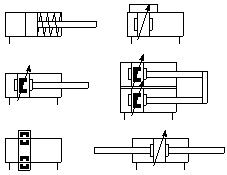Configurable cylinder

The
configurable cylinder can be customized via its
properties
dialog. Almost any combination of
piston type (single-acting, double-acting), the specification of
the piston rods (double ended, with magnetic coupling or slide)
and the number (none, one, two) is possible. An end position
cushioning (without, with, adjustable) can also be defined.
FluidSIM automatically adjusts the symbol according to the preset
configuration.In addition, a load to be
moved (including possible static and sliding friction) and a
variable force profile can be defined in the properties
dialog.
In the component library
from FluidSIM there are several pre-configured cylinders that can
be inserted in your circuit and directly used. Should no suitable
symbol be available, then simply choose the component with the
most similarity to the required component, open the
properties
dialog and adjust the configuration
accordingly.
Adjustable parameters
Max. stroke: 1 ... 5000 mm (200)
Piston position: 0 ... Max. stroke mm (0)
Piston diameter: 1 ... 1000 mm (16)
Piston rod diameter: 0 ... 1000 mm (10)
Mounting angle: 0 ... 360 Deg (0)
Internal leakage: 0 ... 100 l/(min*MPa) (0)
Moving mass: 0 ... 10000 kg (0)
Static friction coefficient: 0 ... 2 (0)
Sliding friction coefficient: 0 ... 2 (0)
Force: -1000000 ... 1000000 N (0)
Related Topics
Double acting cylinder with shock adsorber at stroke end
Double acting cylinder with in and out piston rod and shock adsorber at stroke end
[154] Double acting cylinder with end position cushioning

